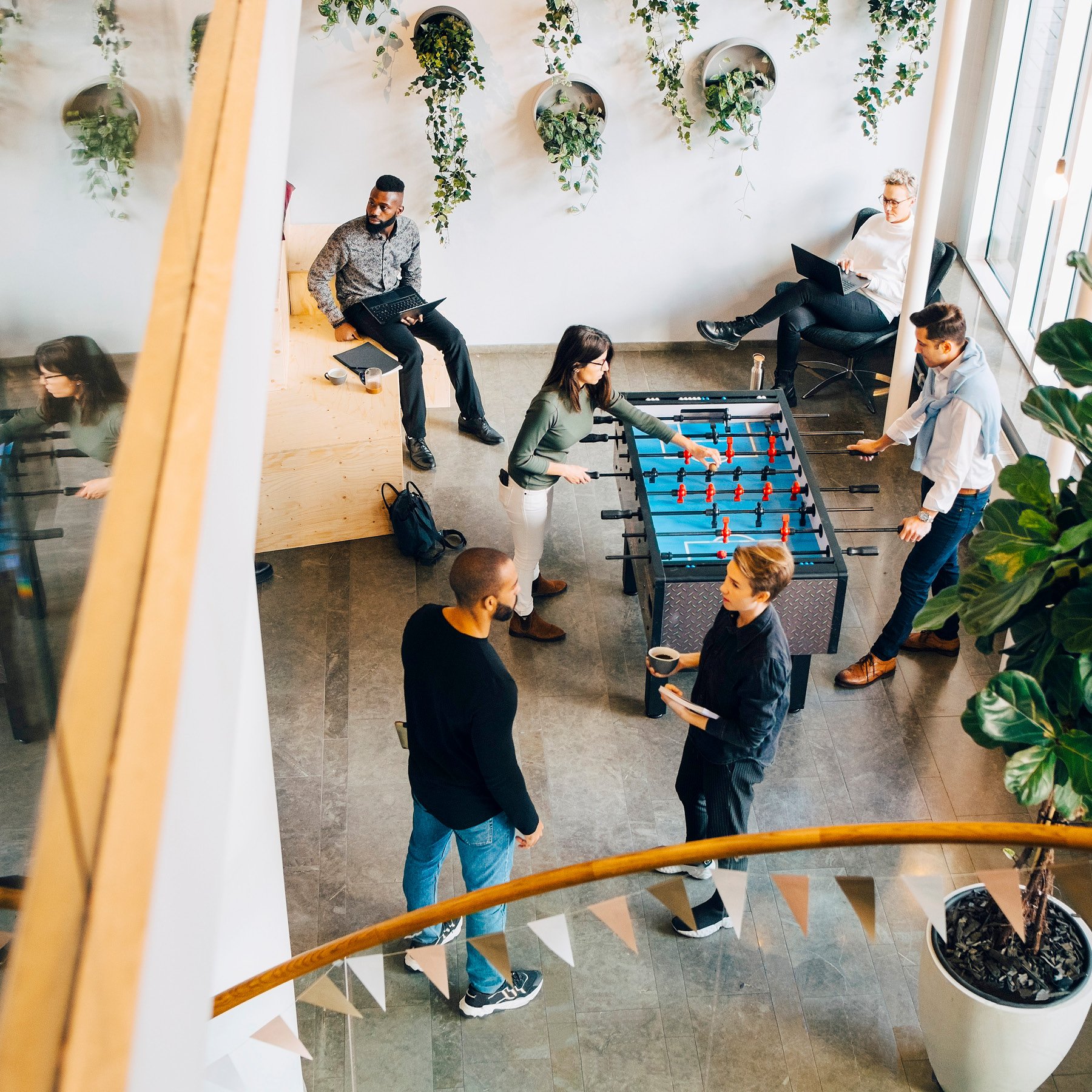Our modern world is fast paced. Words like work-stress, burnout and work–life balance have become common in the vernacular. Finding equilibrium in work and in life is proving increasingly complex. Workforce burnout rates have never been higher, yet productivity is not at an all-time high.
Working more and working harder is not equating to a workforce that is productive or mentally well. The well-known saying ‘work hard, play hard’ has separated work and play in our thinking and in organizations.
However, workplace wellbeing and productivity metrics are demanding we consider a merger between work and play. Could tapping into the power of play refuel workforce productivity?
The Power of Play
The perception is often that play is reserved for children and some even use terms like ‘child’s play’. However, when you learn what play is and what play is not, then you observe play in all life stages and echelons of society.
You only have to sit in a busy airport for a few hours to notice how humans are playful. From the peek-a-boo or chase-me play that builds strong parent-child relationships, to a child making up a ‘floor is lava’ style game as they walk through the long corridors of the airport, or a teenager gaming on a handheld device.

When you learn what play is and what play is not, then you observe play in all life stages and echelons of society.
Adults are also engaging in their own ways of playing, such as Sudoku, Wordle, a crossword, playing cards with a travel companion, listening to music and bopping along, or playfully bantering with a friend or loved one. Some may even be on their way to a fun-filled vacation. These examples demonstrate the range of both play and playfulness within relationships and highlight the role of play in natural human interactions.
When we play throughout childhood and maintain a sense of playfulness into adulthood, one of our seven core emotional neural circuitries – play – is nourished. It is said that ‘nothing lights up the brain like play’. Play is a source of creativity, wellbeing, learning, social relationships and emotional resilience.
Over time, workers and workplaces have become disconnected from this vital resource. Here are seven reasons to consider injecting play into your workplace, to boost productivity, wellbeing and company culture.
1. Play develops strong working relationships
Strong workplace relationships contribute positively to worker engagement, happiness and overall productivity. When strong workplace relationships are not prioritized, toxic workplace conditions can manifest.
Toxic workplace culture is linked with significant negative monetary costs, as well as costs associated with productivity, such as high worker absenteeism, high staff turnover and low productivity. There are many relationship-based components of a positive and productive workplace culture.
Integrating play into the development and maintenance of strong working relationships can reduce disrespectful or unethical behavior and even bullying.
2. Play supports emotional regulation
Emotional regulation and worker peak performance are intertwined in the workplace. When emotional regulation skills and methods are enhanced, not only is performance and productivity improved but the overall psychological health of the workplace also benefits.
Play can be an easy way for workers to recognize different emotions in themselves and others, gain a better understanding of their emotions, and try out novel ways of expressing and regulating their emotions.
When employees can regulate their emotions at work, they work more efficiently, experience greater enjoyment, have more successful workplace relationships and improved career progression.
Some workplaces promote collective emotional regulation through rituals that provide opportunities for emotions to be released. Workplaces can encourage the use of play-based resources for both regulating and releasing emotions at work.
3. Play cultivates creativity and innovation
Play is already being embraced in many creative industries as a way to approach problems from a fresh angle, a source of new perspectives and ideas and an activator for generating original content.
With play experts like Stuart Brown advocating for increased play and fun in workplaces as a way of boosting motivation, productivity and creativity, we are starting to see more companies embracing this innovative approach.

Play is already being embraced in many creative industries as a way to approach problems from a fresh angle.
Play is the ultimate neural activator and connector, meaning play is like a naturally occurring fertilizer that promotes the growth and maturation of creative ideas into workplace innovation.
4. Play elicits authentic/genuine expression of self
The 2019 Globant workplace report on people-first workplace cultures found overwhelmingly that employees desire meaningful workplace relationships.
Play is a wonderful resource for workers when forming and maintaining genuine, close workplace relationships, and it can boost worker confidence so they can feel free to be genuine at work within authentic workplace relationships.
Authenticity in the workplace not only fosters worker engagement, performance and commitment to the organization, but also worker wellbeing both at and outside of work. The spontaneous nature of play assists adults to let their insecurities fall away and be in the moment and have fun with others.
5. Play invites mindful moments
Consider swapping mindful moments at work for playful moments to scale up the benefits to mind and body, enhance task performance and worker engagement and reduce work stress. Practicing mindfulness through play can help us to press pause on the endless stream of thoughts and tasks and restart ourselves – like when we fully restart a computer.
Promoting playfulness as a way of practicing mindfulness can level-up mindful moments. Where mindfulness increases awareness, playfulness replenishes through connection to the imagination.
In the way mindfulness focuses on the self, playfulness can refocus us outward into the workplace environment and culture. And playfulness can shift workers from passive mindfulness toward physically active playful moments.
6. Movement breaks can equal play breaks
Research conducted by Microsoft found workers benefit from downtime throughout the day to reset and restore. This boosts worker energy and engagement. However, downtime does not always mean physical rest; play can transform downtime into playful movement breaks.
Movement breaks aim to restore focus and concentration. And when optimizing the benefit from a movement break it pays to consider both gross motor and fine motor movements.
Gross motor movement breaks can recalibrate the arousal level of workers. For example, a quick dance break might perk workers up who might have been feeling tired or flat, but also relax any high-octane workers who might be stuck in an overly alert state. Alternatively, a fine motor break, like doodling with pen and paper, can bring workers back into connection with their body.
7. Play invites experimentation and reflection – enhancing multiple perspective taking
There is growing research into the many benefits of fun, playful workplaces. A playful work environment is one that encourages workers to progress their ideas through further experimentation and reflection.
Encouraging play in workplace environments and relationships creates and maintains the psychologically safety necessary to experience the freedom to experiment, reflect and integrate multiple perspectives.
Integrating play into the workplace does require some investment in upskilling for both workplace leaders and workers. By learning more about the importance of play for people of all ages, a shared understanding of the benefits in fostering playful resources, atmosphere and relationships within their workplace can be established.

Fostering a workplace culture where the power of play is understood and respected can be an important factor for sustained workplace productivity.
Playful moments may not be possible all the time within workplaces, but fostering a workplace culture where the power of play is understood and respected can be an important factor for sustained workplace productivity.
It’s time to re-learn how to harness the play potential in our workplaces. Play helps us think outside the box; play can comfort us when we are distressed; play keeps us socially connected; play will ensure we keep up with innovative change; and importantly, play anchors us to our humanity as we increasingly connect with new technologies.







